Hair Transplant
Hair transplant is a kind of technique for moving hair roots from one area to another area, i.e., from side or rear area of the head with the largest amount of the strongest hair. Each hair graft that is expected to have the number of hair roots as demanded is removed. Subsequently, each hair root is separated by using microscope from 2,000 – 6,000 grafts consuming 2-4 hours. All hair roots will be moisturized by providing saline. Subsequently, prepared hair roots will be grown on the patient’s head.
Currently, there are 2 main methods of hair transparent that are preferred:
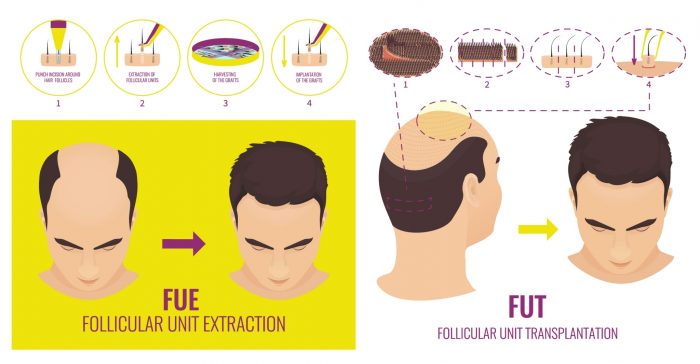
ภาพแสดงวิธีการปลูกผมแบบ FUE และ FUT

FUE is the removal of each follicular unit individually with a small punch device from the rear area of head (with strong hair) for transplanting in the head’s areas with thin hair or bald without scalp cutting therefore there is no anxiety on scars.
To use FUE technique, a skillful physician will inject anesthetic or ask the patient to take a mild sleeping pill. Subsequently, the physician will start treatment/hair transplant with FUE technique that give the best outcomes on beautiful and natural look. The patient can live his/her life normally after hair transplanting.
FUE technique is the use of a small punch device with the size ranged from 0.6-0.9 millimeters to punch around hair grafts on defined areas to reach hair roots that are mostly located on the back part of the skull. Subsequently, those strong grafts will be pulled out and new follicular units will be transplanted in demanded areas under the same method as used in FUT technique. All procedures highly require details, fines, and specialized skill of the physician.
Advantages of FUE
After hair implanting, the patient will feel pain on rear area of the head less than that of FUT technique because there is no slivering. In addition, the patient will feel no head’s stiffness therefore it is suitable for hair transplant with fewer amounts of grafts and small hair can be transplanted with this technique as well therefore, it is suitable for growing eyebrow and eyelash. Hair from other parts of body (e.g., beard, mustache, chest hair, arm hair, and shin hair) can be transplanted on head but it is not preferred because such transplanted hair will almost be wavy and short giving unnatural look compared to that of head hair.
Disadvantage of FUE
Hair roots removed from scalp may be broken and incomplete affecting to poorer growth of new hair compared to that of FUT technique. In addition, it also consumes a large amount of time leading to limited number of grafts obtained in each transplant. To perform FUE technique, the number of grafts should not be over than 3,000 grafts per transplant while larger amount of grafts can be obtained from FUT technique based on stiffness of scalp of the rear area and density of hair on the back of the skull that may be lower by 20%.
Procedures of FUE Technique
Procedure 1: Preparation for Hair Transplant
The surgeon will design new hair line of hair transplant to meet with the patient’s facial structure, determine transplanted areas, and calculate number of grafts. Hair on the rear area of the scalp will be shaved to be shorter for facilitating removal of strong follicular units for transplanting on demanded areas.


Procedure 2: Punching for Pulling Follicular Units
The surgeon will inject aesthetical to demanded areas and the patient will gain no pain after its activeness. The hair of selected areas will be sterilized and the surgeon will use a small punch device with the size ranged from 0.6-0.9 millimeters to punch each hair hole to reach its follicular unit. Subsequently, the surgeon will use Forceps to pull follicular units from scalp for keeping in hair root treatment for moving such follicular units for transplanting in demanded areas.
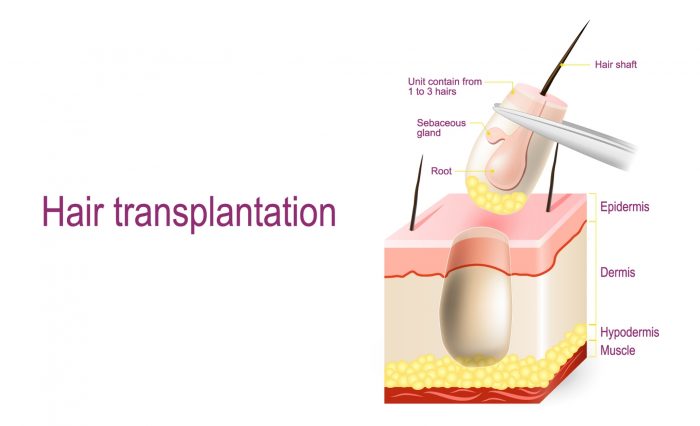
Procedure 3: Punching for New Hair Transplant
To transplant grafts in demanded areas, the surgeon will use 2 units of sharp Forceps and he will use one hand to open hair hole while graft will be inserted in such hole by another hand. To lower bruise of follicular units, the surgeon will punch hair holes and transplant new hair in those holes in order to increase density of hair on demanded areas.
Procedure 4: Grafts Transplanting
This procedure may require 4-6 hours or longer depending on number of demanded follicular units. During this procedure, the patient will have 10-15 minutes for having a meal and taking a rest intermittently. After completing hair transplant, the nurse will wrap the patient’s head and the patient may have swelling on his/her forehead or some pimples occurred on hair holes that can be cured by taking some antibiotics. In addition, the patient may feel numb on his/her scalp after hair transplanting but it may be gone naturally.
Procedure 5: Normal Daily Life Living
The patient will be able to wash his/her hair in the next morning after hair transplant and will be able to wash his/her hair every day without any worry on inflammation or infection (We will wash the patient’s hair and teach him/her how to wash his/her hair for 5 days). After hair transplant, the patient must comply with the surgeon’s suggestions. The patient is able to sleep with turning face up but he/she should wear a head band) for a period of time that is generally suggested for 5 days in order to prevent facial swelling. During the first period after hair transplant, there may be some hair fall and hair roots will be recovered within 3-4 months approximately. Subsequently, new hair roots will be grown and the rate of hair growth will be equal to that of normal and natural hair. As a result, the duration of effectiveness with beautiful and long hair is around 8-10 months.
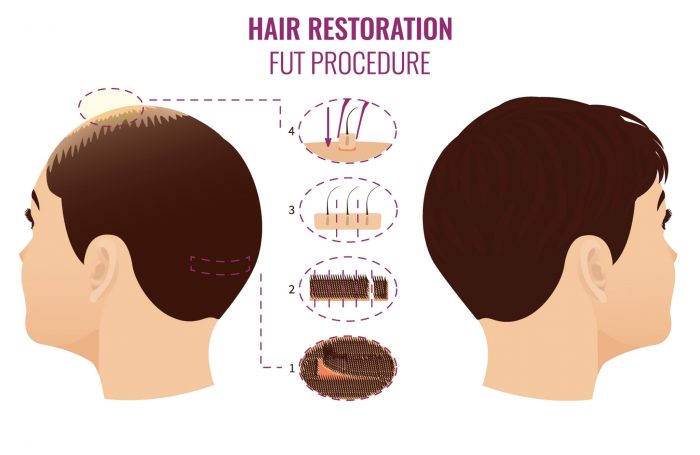
Follicular Unit Transplantation (FUT) or Strip Technique is a conventional method of hair transplant requiring surgery and it has been utilized extensively for long period. However, hair transplant is currently developed to be FUE technique and this technique is increasingly mentioned and preferred because it gives no scar and awful feeling like general hair transplant methods. Since many people are afraid of surgery, FUE technique can respond their demands. However, strip or FUT is still considered as a standard method that is generally used.
Advantages of FUT
In one surgery with FUT technique (operated with the same patient), the maximum number of obtained grafts may be 3,500 grafts depending on health of the patient’s scalp. Grafts will be separated by microscope causing only minor bruise with healthier condition. The duration of this technique is shorter compared to that of FUE technique. Moreover, this technique is also cheaper.
Disadvantages of FUT
It gives some long scars and requires a large number of skillful personnel that is averagely 6-8 personnel per 1 patient.
Procedures of FUT Technique
The surgeon will design and draw a new hair line to suit with the patient’s facial structure. Subsequently, the surgeon will select some hair roots from the rear area of the scalp from the back of the skull to the ear (with the width of 1-2 centimeters depending on the number of demanded grafts). The patient’s hair will be tied with gummed tape before cutting to be shorter.
Anesthetic will be injected in demanded scalp for slivering.
Slivered scalp will be drawn with hair line and local anesthetic injection will be performed along the line for slivering.
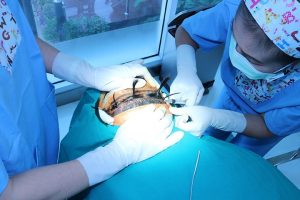
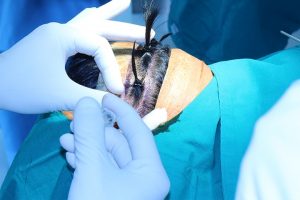
Open Technique
When anesthetic is active, the surgeon will start to cut along the drawing line. Subsequently, the surgeon will use small hooks to hold and open the wound while slivering scalp carefully with a scalpel until the line of hair roots can be seen clearly.

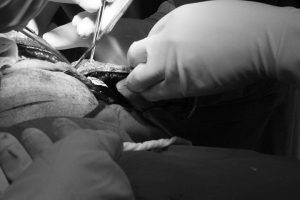
Stitching
After slivering, the wound will be stitched with chromic catgut for one layer followed by non chromic catgut for another layer in order to accelerate recovery. After 7 days, the patient will be appointed to receive stitches off.
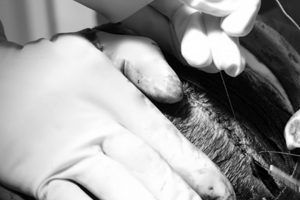
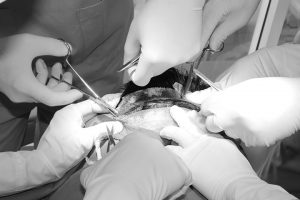
Graft Slivering
The slivered scalp in long shape will be slivered before being separated as each Follicular Unit. When watching through a microscope with 10X zooming, each follicular unit or graft consists of 1-4 micrografts and they will separated and soaked in hair root treatment in order to remain completeness and reduce the death of hair roots before transplanting.


Graft Transplanting
Before performing hair transplant, the surgeon will perform local anesthetic injection into 2 locations, i.e., above both eyebrows, before punching in order to grow hair roots. After anesthetic injection, the patient’s forehead to the middle area of the head will be numb. Hemostatic agent will be injected with saline in order to swell scalp. Subsequently, the surgeon will punch some hair holes and insert follicular units in those hair holes in order to increase density of hair in demanded areas. There may be bleeding in such areas and the patient may have swollen forehead after hair transplanting or feel numb on his/her scalp. Such symptoms will be gone naturally and the patient will be able to live his/her life normally.
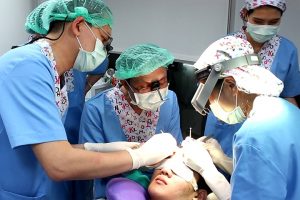
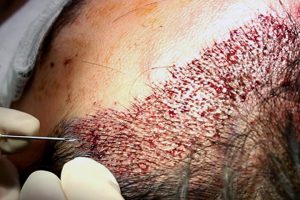
The patient will be able to wash his/her hair in the next morning after hair transplant and will be able to wash his/her hair every day without any worry on inflammation or infection (We will wash the patient’s hair and teach him/her how to wash his/her hair for 5 days). After hair transplant, the patient must comply with the surgeon’s suggestions. The patient is able to sleep with turning face up but he/she should wear a head band) for a period of time that is generally suggested for 5 days in order to prevent facial swelling. During the first period after hair transplant, there may be some hair fall and hair roots will be recovered within 3-4 months approximately. Subsequently, new hair roots will be grown and the rate of hair growth will be equal to that of normal and natural hair. As a result, the duration of effectiveness with beautiful and long hair is around 8-10 months.


Successful Hair Transplant: Hair roots must be grown over 98% and this success is mainly based on experience, techniques, and expertise o the surgeon.
Possible Side Effects are head pain and stiffness, numb feeling and swelling of forehead.
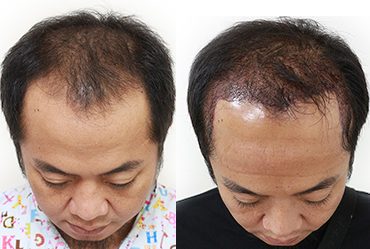

(The results depend on the individual.)
